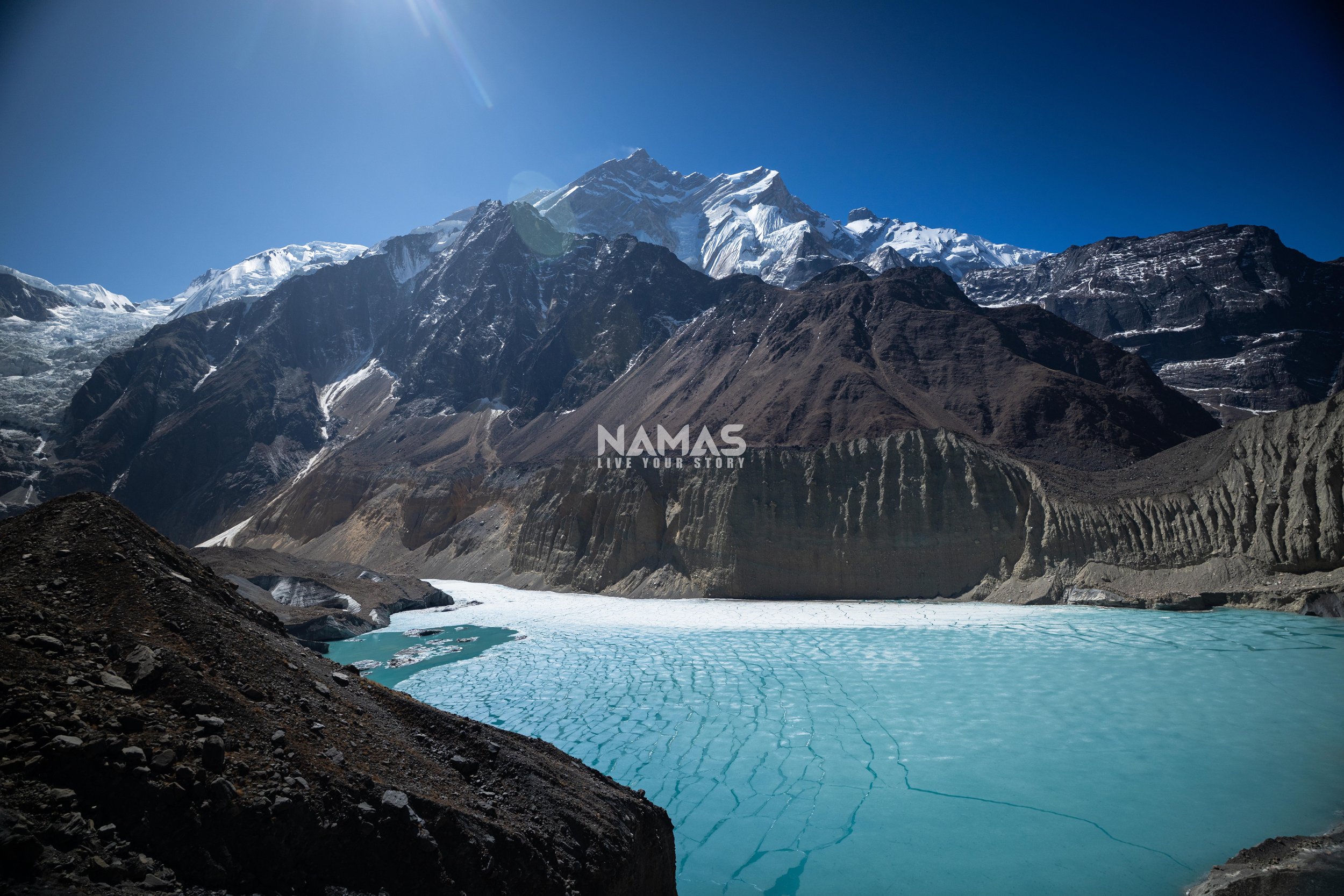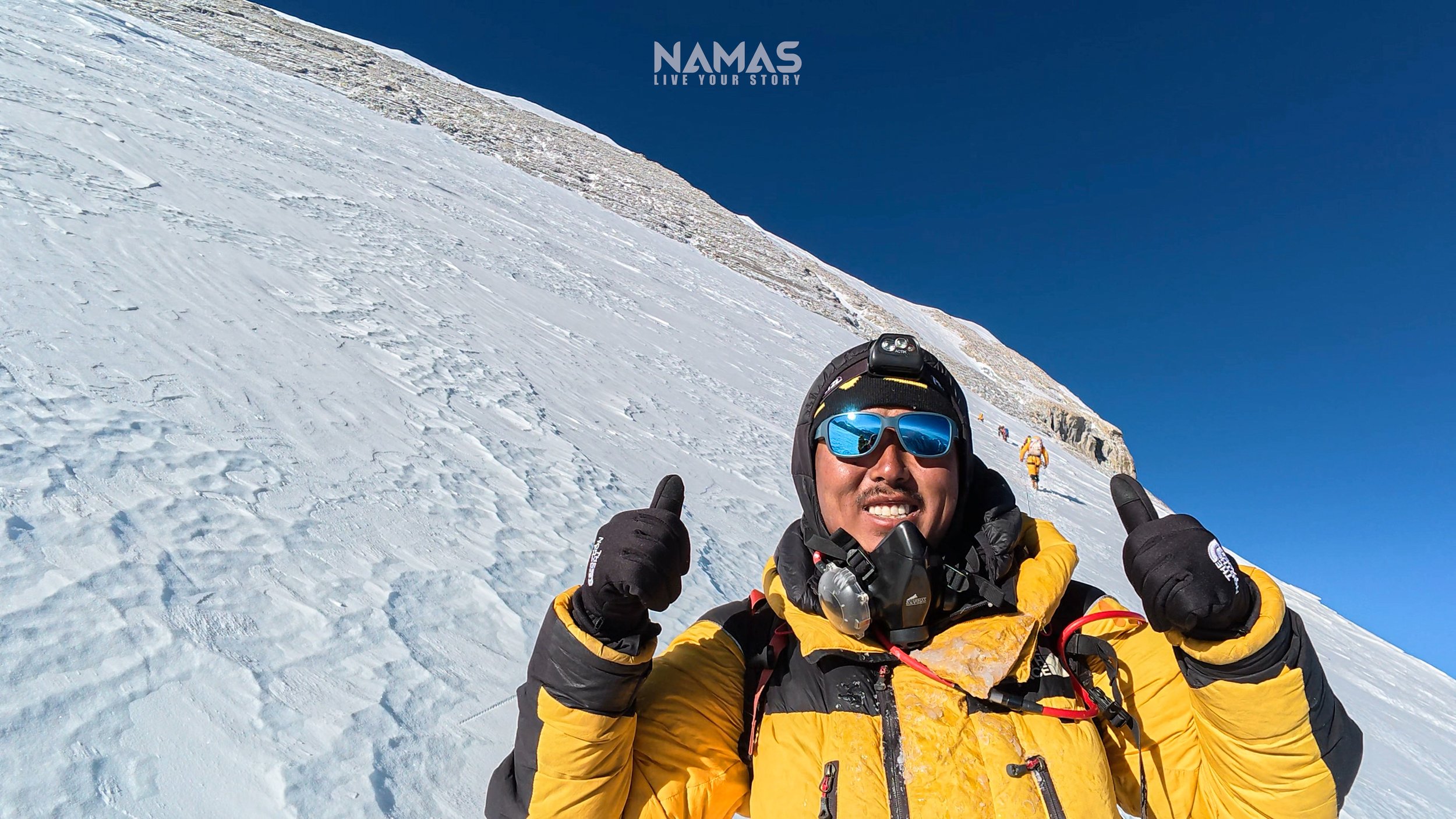Experiences, fitness level and skills required to climb Annapurna 1, 8091m expedition - Namas Adventure
NAMAS TEAM. 2025 Annapurna 1 expedition
Annapurna I (8,091m / 26,545 ft) is the 10th highest mountain in the world, but far more notable is its reputation: Annapurna I has one of the highest fatality-to-summit ratios among all 8000-meter peaks. Avalanches, unstable snow conditions, and highly technical climbing routes make this mountain a formidable challenge—one that only experienced and highly prepared climbers should consider.
If you're thinking about attempting Annapurna I, this guide will help you understand exactly what kind of experience, training, and mindset you need before taking the first step.
What Kind of Climbing Background Is Needed for Annapurna I?
Annapurna I is not suitable for beginner or intermediate climbers. Attempting it without adequate experience can be life-threatening. Climbers must possess a strong foundation in alpine mountaineering, with multiple expeditions in progressively higher and more technical environments.
✅ Essential pre-requisites
To be a strong candidate for Annapurna I, you should have completed:
Multiple 4000m–6000m Technical Climbs
Examples: Khumbu 3 Peak, Chulu West, Aconcagua, Mt. Blanc, or similar grade peaks in the alps or anywhere around the world
hese climbs help build endurance and basic alpine climbing skills.At Least One or Two 7000m+ Expeditions
Examples: Tilicho Peak, Annapurna IV, Himlung Himal, Lenin Peak or similar graded peaks
These peaks expose you to thinner air and cold environments while introducing more technical and logistical challenges.Experience on 8000m Peaks (Strongly Recommended)
Examples: Manaslu, Everest, Cho Oyu, Makalu
Climbing one or more of these peaks helps develop critical judgment, pacing, and survival skills at 8000M extreme altitudes.
🧗♀️ Optional but Valuable:
Climbs like Ama Dablam, Alpamayo, or other alpine climbing serve as great preparation climbs due to their technical terrain and challenging weather.
🧰 Technical Skills You Must Master
Annapurna I demands more than fitness—it requires precise execution of technical mountaineering techniques. You'll face ice walls, steep rock faces, seracs, crevasses, and avalanche-prone zones.
🔧 Required Technical Skills
Ice Climbing Proficiency
– Comfortable on WI3–WI5 routes
– Ability to climb frozen waterfalls and vertical ice safely and efficientlyMixed Climbing Experience
– Routes rated MI6–MI7 (combination of rock and ice)
– Secure climbing on steep terrain involving crampons, ice axes, and rock protectionRock Climbing Ability
– Experience with multi-pitch routes
– Rock grades of 5.9–5.10a/b/c are ideal (indoor or outdoor)Climbing steep and exposed faces
– Knowledge of how to traverse and climb securely on steep faces
– understanding of moving in unstable and dangerous sections on the mountainsRope Systems & Gear Usage
– Proficient with fixed ropes, jummars (ascenders), rappelling, anchor building, and crevasse rescue systems
This isn’t just for safety—it’s for survival. You need to be able to execute these techniques with muscle memory, even under fatigue or in poor weather.
🧠 Mental Resilience: Your Most Important Asset
Mountaineering at this level tests your mental endurance as much as your physical ability. Annapurna I is notorious for long waits due to bad weather, moments of extreme doubt, and the psychological strain of climbing through high-risk zones.
👊 Mental Skills You’ll Need:
Patience & Decision-Making Under Pressure
– Weather windows are short, and mistakes at 8000m can be fatal. You must know when to push forward—and when to turn back.Resilience & Stress Management
– Mental fatigue is common, and you’ll need the strength to keep moving when your body is screaming to stop.Focus & Self-Awareness
– Many accidents happen due to small lapses in judgment. Staying alert even at your limit is critical.
Tip: Many climbers incorporate visualization, meditation, and mental endurance training into their expedition prep.
🏋️ Physical Conditioning: Training for Annapurna I
The mountain doesn’t care how many peaks you’ve climbed before—it demands elite-level fitness. A summit push could mean 12-15 hours of climbing in a single day, with a 10kg+ pack, at altitudes where oxygen is only one-third of sea level.
🧬 Fitness Level: 5 (Elite)
Your training should begin 6 to 8 months in advance and include:
🫁 Cardiovascular Endurance
Long duration alpine climbing in steep faces (5 - 6 hours minimum)
Long-distance running (half-marathon to marathon distances)
Road or mountain cycling (4–6 hours)
High-altitude hiking with elevation gain
💪 Strength & Load Carrying
Weighted backpack climbs (20–30 kg / 45–65 lbs)
Leg and core workouts
Strength training focused on endurance (CrossFit, kettlebells, squats, lunges)
🧘♂️ Flexibility & Mobility
Yoga or dynamic stretching
Prevents injury and maintains agility on technical terrain
🧗♂️ Simulated Climbing
Indoor or outdoor climbing gyms
Ice climbing practice WI4, mixed climbing routes MI7, and real exposure to alpine routes
Final Thoughts: Is Annapurna I Right for You?
Climbing Annapurna I is a bold, dangerous, and life-altering adventure. It’s not a goal to be rushed or taken lightly. If you’ve built a solid foundation of experience, technical skills, and physical/mental strength—and if you’re prepared to face one of the most unforgiving mountains on Earth—then you may be ready to take on this challenge.
Remember: The mountain isn’t going anywhere. Take your time. Climb smart. Live to tell the story.
Annapurna I: Where Preparation Meets Purpose
Climbing Annapurna I isn’t just about reaching the summit of the world’s 10th highest peak—it's about pushing your limits, embracing uncertainty, and discovering who you truly are in the face of one of Earth’s greatest challenges.
Taking on this formidable mountain requires more than just ambition. It demands a deep reservoir of high-altitude climbing experience and a strong grasp of technical skills—rock and ice climbing, rope systems, traverses, and the ability to move confidently across exposed, unpredictable terrain. But if you don’t have peaks to train on nearby, don’t let that stop you. Dive deeper into indoor and outdoor climbing, sharpen your technical edge, and build your strength wherever you can. Every climb, every session, every effort counts.
While expedition logistics are expertly managed by seasoned teams, including the legendary Sherpa leaders of Nepal, Annapurna I is still a mountain that commands respect. These guides—many of whom call this their favorite climb—bring a level of wisdom and courage earned from a lifetime in the Himalayas. Their presence opens a gateway to one of the most thrilling, soul-shaping climbs on Earth.
But make no mistake—this is a team effort. The success of the journey depends on every link in the chain, from the crew that supports you behind the scenes to the climbers who share your rope. Once you’ve committed, it’s time to train with intention. Build your endurance. Strengthen your resolve. Prepare not just your body, but your mind—for moments of awe, for tests of willpower, and for the kind of growth that only the mountains can deliver.
So if your heart races at the thought of standing beneath that towering summit, surrounded by silence and sky, listen to that call.
Challenge yourself. Go. Live Your Story.
Are you considering an ascent of Annapurna 1 in Nepal? If you are eager to tackle this stunning and challenging peak and progress to even higher mountains, the team at Namas Adventure is here to help make your dream a reality. We would be happy to assist you with any questions you may have regarding the expedition. To contact us, please email us at bookings@namasadventure.com and one of our team members will be happy to assist you.
Visual journey of Annapurna I, 8091M Expedition - NAMAS ADVENTURE
Route from camp 1 to Summit of Annapurna 1
Early reminder - Click to enlarge on images
Annapurna I, rising to 8,091 meters, is the 10th highest mountain on Earth and the highest peak in the Annapurna massif. Known for its extreme difficulty and high fatality rate, Annapurna I has earned a reputation as the most dangerous 8000-meter peak in the world. This mountain is not for the faint-hearted—it’s a true test of survival, skill, and endurance.
Unlike Everest or Manaslu, very few climbers attempt Annapurna I each year, making it an excellent objective for those seeking a quieter, more technical 8000-meter expedition. With the right high-altitude experience, Annapurna I is a dream peak for climbers wanting to challenge themselves on one of the boldest climbs in the Himalayas.
Start Point: Kathmandu
Acclimatization Trek: Mardi Himal trek up to 4,000M, highpoint
Base Camp Access: After acclimatization, we take a helicopter from Pokhara to Annapurna I North Base Camp (4,090M)—a 25-minute flight offering stunning aerial views and a remote, peaceful entry to the mountain.
Acclimatisation trek to Mardi Himal, high point 4000M
Dhaulagiri seen on our approach to Annapurna North BC
Annapurna 1 North Base camp, 4090M
Annapurna I Base Camp 4090M
Sitting just above the stunning torquiest Lake, Annapurna I Base Camp offers a remote and breathtaking staging ground for one of the world’s most demanding climbs. With its serene setting and strategic altitude, it’s the perfect place to launch your expedition into the heart of the Himalayas.




Route to Camp 1 5100M (4-6 hours)
The approach to Camp 1 (5,100M) on Annapurna I begins with a rappel down a steep moraine, followed by a glacier traverse across crevassed terrain. From there, climbers ascend the rocky ridge line to the left of the glacier, navigating technical sections to reach the exposed and dry Camp 1 at 5100M.
Route to camp 1
Camp 1 at Ananpurna 1, tucked just by the giant glaciers
Route to Camp 2 5600M - 5600M(5- 6 hours)
From Camp 1, the route to Camp 2 begins with a crossing of glacier fields, followed by an ascent on black rocky terrain. The climb gradually shifts from a steep rocky incline to sections of hard blue ice, demanding technical precision and stamina.
Although this is the shortest section between camps.
From camp 1, overseeing the rest of the climbing route.
Annapurna 1, Camp 2, 5500M
camp 2, over gazing over the route to camp 3.
Camp 2 is set amidst dramatic glacier formations, offering a surreal and rugged high-altitude environment. Its location has been strategically chosen to avoid major avalanche zones, making it a relatively safer resting point compared to other exposed areas.
However, the camp sits on a slightly slanted slope, and if multiple teams are on the mountain, finding a flat, secure tent platform can be a challenge. Proper planning and early positioning are key to securing a good campsite here.
camp 2, 5500M
Route to Camp 3 (8 - 10 hours)
Camp 2 to Camp 3 on Annapurna I is where the mountain truly reveals its unforgiving nature — a section often described as the most dangerous and technically demanding part of the entire climb.
This stretch is a steep, mixed terrain gauntlet — with unstable rock, avalanche-prone slopes, and sheer vertical ice walls. The route begins with loose rock underfoot, demanding full concentration with every step. But the real challenge lies ahead: a narrow, icy couloir guarded by a steep ice wall — the first major crux of the climb.
This couloir is notorious. Avalanches funnel directly through this choke point, and there is no alternative route. It's a place where you move with urgency and precision, hoping the mountain stays still while you pass. Climbers begin before dawn, when the ice is most stable and avalanche risk is at its lowest. Every move must be calculated. Every moment is intense.
But once you make it to Camp 3, perched precariously above the chaos below, there’s a powerful sense of relief. You’ve overcome the most dangerous, vertical, and technical section of Annapurna I. And from here, climbers say, if your body holds, your chances of reaching the summit are real.
It’s a section that humbles even the most seasoned mountaineers — a passage where courage meets caution, and where the line between fear and focus is razor thin.
This is the unavoidable avalanche zone — a notorious section where the route cuts directly through the heart of the danger. There’s no alternative path; every climber must pass through this narrow couloir where avalanches have a direct line of fire.
Annapurna I, arrival Camp 3 6500M
Cracked serac above camp 3. You just pray this does not fall.
Route to the Summit of Annapurna I 7525M (12 - 15 hours)
The climb from Camp 3 to the summit is a steady uphill push with fewer technical sections compared to the lower route, but it still demands endurance, focus, and determination.
An early alpine start marks the beginning of summit day — a long, rewarding journey toward your ultimate goal. Expect a full day on your feet, moving at altitude, carefully pacing yourself, and keeping a close watch on weather and wind conditions.
Most climbers allow for a 12–15 hour window to reach the summit, followed by a 5–7 hour descent back to Camp 3. It's a long, committed day, but for those prepared, it offers one of the most incredible and fulfilling experiences in high-altitude mountaineering.
Annapurna 1, summit
The summit of Annapurna I lies just beyond the final steep couloir—a last, focused push before reaching the top of one of the world’s most formidable peaks. The summit itself is small and sharp, with space for only one or two climbers at a time, making the moment even more intimate and powerful.
From the top, the panoramic view is absolutely breathtaking. You’re surrounded by the entire Annapurna range—Annapurna South, Annapurna II, III, IV, Tilicho Peak, Gangapurna, and the unmistakable silhouette of Machhapuchhre (Fishtail Peak) standing proudly in the distance.
It’s a summit earned through grit and resolve—and one that rewards you with some of the most spectacular mountain vistas on Earth.
Ready to turn your dream of summiting Annapurna I into reality?
Join us for our Spring Annapurna I expeditions, operated annually with expert guidance and full expedition support.
For more details on Annapurna I, Annapurna IV, or any of our other high-altitude climbs, visit our website or get in touch directly:
📞 Call/WhatsApp: +1 347-476-9547
📧 Email: bookings@namasadventure.com
Let’s plan your next big mountain goal—because your story deserves a summit. 🏔️
Images by - Bisesh Gurung (Chief Adventurer)
Namas Adventure Team
Live Your Story
7000M and 8000M expedition 2025 departures - Namas Adventure
Planning your next high-altitude adventure? Namas Adventure's 2025 departures for 7000M and 8000M peaks cater to climbers of varying skills, from entry-level enthusiasts to advanced level climbers. For more detailed information about each expedition, please click on the expedition name.
7000M
Entry Level
Perfect for climbers with basic technical skills and a good fitness level. Climbers must have experience at altitudes over 5000M - 6000M and are looking to push their limits further:
Intermediate Level
Ideal for those with some high-altitude experience, good technical skills, and fitness level.
Advanced Level
Suitable for climbers with advanced skills and experience.
8000M
Entry Level
For climbers with intermediate technical skills and great fitness. Must have previous experience at altitudes over 6000M, including at least one 7000M peak.
Advanced Level
The ultimate test for top-tier climbers, requiring advanced technical knowledge and peak physical fitness.
Whether you're looking to step up your climbing game or tackle the world's highest peaks, Namas Adventure has an expedition for you. Join us to reach beyond the clouds and achieve the extraordinary in 2025.
Inquire here
Namas Adventure Team
LIVE YOUR STORY




















